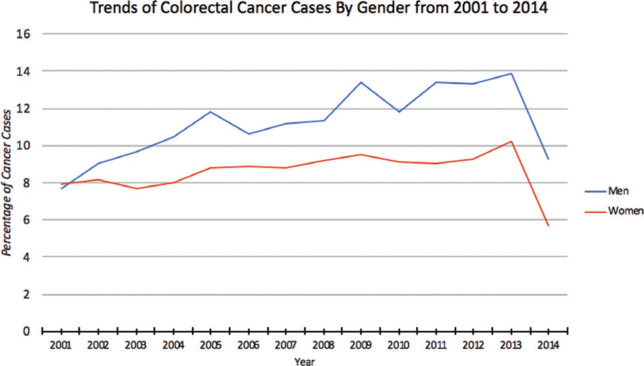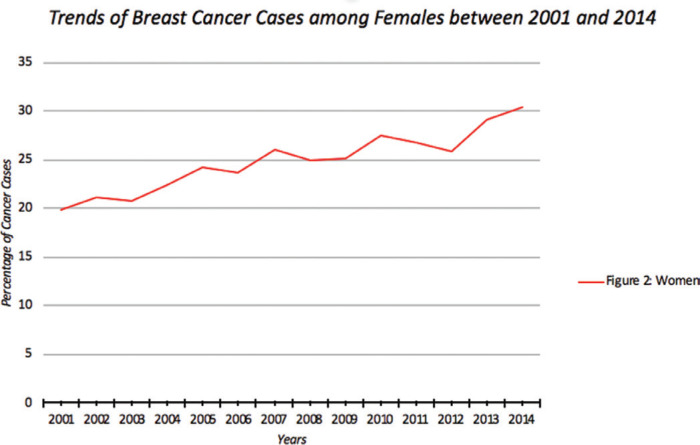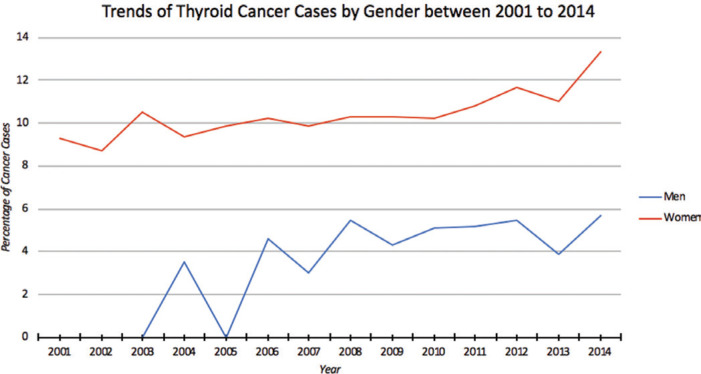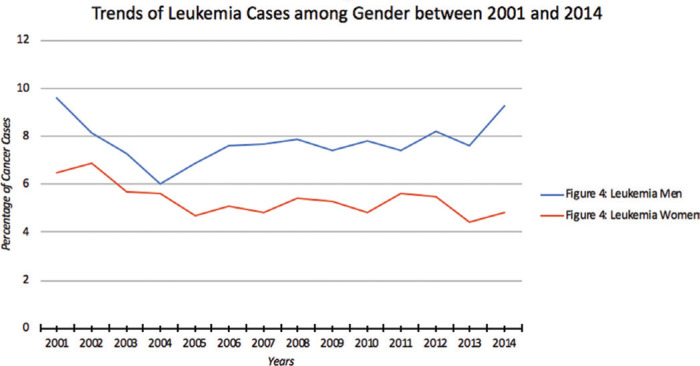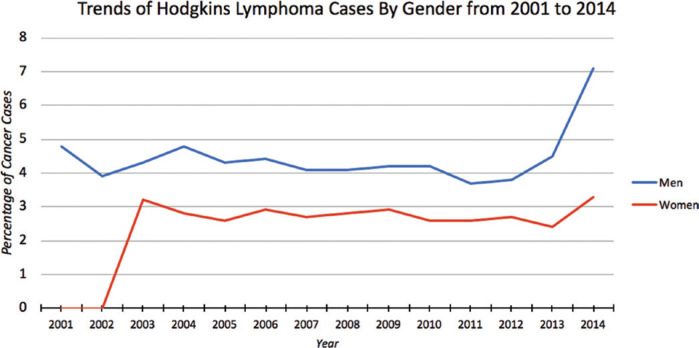Abstract
Background: Cancer epidemiology in Saudi Arabia (SA) differs from that of the USA with respect to types of common malignancies. Hematologic malignancies are among the top five cancers prevalent in SA, including lymphoma and leukemia. Most common malignancies in SA also include breast, thyroid, and colorectal cancer. We sought to evaluate the current trends of these most common cancers in SA.
Methods: Electronic search analysis pertaining to Hodgkin’s lymphoma, leukemia, breast, colorectal, and thyroid cancer were carried out from two databases: The Saudi Cancer Registry (SCR) and the Surveillance, Epidemiology, and End Results (SEER). Data on prevalence and incident frequency were collected. Trends from 2001 to 2014 were calculated and compared between SCR and SEER.
Findings: Leukemia is the most common cancer type among males in SA, followed by colorectal cancer. Hodgkin’s lymphoma has become the third most common malignancy among Saudi males. Percentage of women’s breast cancer and thyroid cancer among total cancer cases have increased by 10.5% and 1.7% respectively from 2001 to 2014, making them the first and second most common cancers in women respectively. Trends of thyroid cancer among males has been stable. Colorectal cancer stands as third most common among Saudi females.
Interpretations: There have been significant changes in trends of incidence rate of the most common cancers in SA among both males and females over the past decade. Breast cancer rates have risen at an alarming pace. More epidemiological studies need to be conducted to evaluate etiological factors at environmental, molecular, and genetic levels.
Keywords: Breast cancer, Hodgkin lymphoma, colorectal cancer, leukemia, thyroid cancer, prostate cancer, adenocarcinoma, papillary carcinoma, consanguinity, radiation
1. INTRODUCTION
Saudi Arabia (SA) is a country with a population of 33 million and differs from the rest with respect to disease epidemiology as it carries one of the highest rates of consanguinity worldwide. The Saudi Cancer Registry (SCR) was established in 1994 to capture the basic epidemiology of cancers in SA. The SCR collects data from healthcare facilities throughout SA; all newly diagnosed cases of cancer are recorded, with information on-site and histology. According to the recent report published by SCR utilizing data up to 2014, cancer incidence varied significantly by gender, with colorectal cancer (13.3%), non-Hodgkin lymphoma (8.4%), and leukemia (8.2%) being the most common types in males [1]. This contrasts to a very different profile of epidemiology in the European and North American (especially US) countries where solid cancers are much more common than hematologic malignancies. There is a literature gap in identifying the current trends and epidemiology of cancers in SA despite significant changes in the culture (food, living, and consanguinity) over the past two decades. Thus, we sought to evaluate the current spectrum and trends of common cancers in SA.
2. MATERIALS AND METHODS
Patient with cancers in SA between 2001 and 2014 were included in this study. The SCR (published reports) were retrospectively analyzed from 2001 to 2014. Only patients with the selected types of cancer were included in this study. Selection was done based on earlier epidemiologic estimates on cancers in SA. The data analysis was carried out using the SPSS statistical software package. For the present report, age-standardized and age-specific incidence rates were calculated, with attention to gender-specific and regional differences in respect to diagnosis only. Otherwise, frequency and incidence rates were assessed regardless of age groups. The change in frequency in percentage for each site of cancer was mentioned. Data from the SCR was compared with data from the Surveillance, Epidemiology, and End Results (SEER) data from the US, in terms of prevalence and incident frequency. Additionally, the distribution of histological type and stage at diagnosis for the cancers was included in the incidence for each cancer.
3. RESULTS
In the Saudi Arabian cohort, leukemia, colorectal carcinoma, and Hodgkin lymphoma were found to be the most common malignancy types among males. Breast, thyroid, and colorectal cancers were found to be the most common malignancy types among females.
3.1. Colorectal Cancer
Colorectal cancer stood as the third most common cancer among Saudi females, but has moved from the fourth most to the top three most common cancers among Saudi men between the years of 2001 and 2014 [2]. The percentage of adenocarcinomas in colorectal cancer cases increased from around 69.9% of cases in 2001 to 79.9% in men and 79.3% in women in 2014. According to the SCR, the most common histological presentation of colorectal cancer among both males and females was the mucinous adenocarcinoma, and the second most common was the signet ring cell carcinoma. Colorectal cancer cases had increased from 7.7% to 9.3% of all cancer cases for men, but showed a slight decrease in cases for women, going from 7.9% to 5.7% from 2001 to 2014 (Figure 1) [2,3]. As shown in the SCR, around 37% of patients diagnosed with colorectal cancer between 2000 and 2010 were younger than 50 years of age. As the second most common cancer among Saudis by gender, the latest 2014 report shows that around 1760 cases out of the 11,663 total cancer cases were of colorectal cancer making the disease one of the most common ones among men and women.
Figure 1.
Trends of colorectal cancer cases among total cancer cases in SA in both genders between 2001 and 2014 according to SCR data
3.2. Breast Cancer
During the same period of time, breast cancer had increased from one-fifth of women’s cancer cases to one-third of cancer cases. The median age of diagnosis of breast cancer was around 50 years. Due to the significant number of breast cancer cases in women, as shown in the 2014 SCR statistics, the number of cases for women alone were 1826 cases, just over 30% of all women’s cancer cases. From 2001 until 2014, the percentage of Saudi women’s breast cancer cases has increased from 19.9% to 30.4%, meaning that over one-fourth of all cancer cases now in women are breast cancer, as opposed to one-fifth of cases 13 years before (Figure 2). The crude frequency of breast cancer among Saudi women was 15.9%. The most common morphology of women’s breast cancer was Infiltrating Duct Carcinoma (78.7%), followed by the lobular carcinoma, in women’s breast cancer cases reported in 2014 [3]. Numbers of cases with medullary carcinomas, malignant phyllodes tumors, and intracystic carcinomas have all increased. There was only one male case of breast cancer in the kingdom in 2014.
Figure 2.
Trends of breast cancer cases among total cancer cases in females in SA between 2001 and 2014 according to SCR data
3.3. Thyroid Cancer
Although the number of thyroid cancer cases were not significantly high, they still stood among the most common cancers in SA in which the percentage of cases increases almost every year as compared to other cancer types. Thyroid cancer in women had increased from 9.3% to 13.3% while in men it has shown to have more or less a stable trend with 5.7% of male cancer cases in 2014 (Figure 3). According to the SCR, thyroid cancer was the second most common cancer among women affecting mainly those around the age of 45, and the 12th most common cancer among men. Since thyroid cancer is three times more likely to occur in women than men in the Saudi population, it had been more prevalent in women from 2001 to 2014 [4]. The morphology of thyroid cancer shown in most cases consisted of papillary adenocarcinomas in the thyroid, making up around 46.5% of cases, an increase by 3.7% since 2001. About 59.5% of thyroid cancer cases were detected while the malignancy was still localized. About 29.5% of cases were detected when the cancer was regional, and 4.8% with distant metastasis.
Figure 3.
Trends of thyroid cancer cases among total cancer cases in both genders in SA between 2001 and 2014 according to SCR data
3.4. Leukemia
There was a slight decrease in frequency of Leukemia cases in males and females, but it is still one of the four most common malignancies in the nation. The high crude relative frequency of leukemia constituting 9.3% of male cases, and 4.8% of female cases seen in SA in 2014 (Figure 4), as compared with 9.6% of male cases and 6.5% of female cases in 2001, marking a 1.7% decrease for females between 2001 and 2014, and a 0.3% decrease in cases in males. Most leukemia cases were diagnosed for patients under 20 years of age. However, these figures are still high compared with those in SEER, where leukemia consisted of 3.1% of all neoplasms overall diagnosed in the US.
Figure 4.
Trends of leukemia cases among total cancer cases in both genders in SA between 2001 and 2014 according to SCR data
3.5. Hodgkin Lymphoma
The incidence of Hodgkin Lymphoma (HL) is comparatively more frequent in SA than in the west. The Nodular Sclerosis (NS) sub-type constitutes 229 out of the total 411 cases of HL in SA in 2014. Diagnosis of Hodgkin Lymphoma was mainly during the fifth decade of life. Following this was the HL-NOS (not otherwise specified) shown in 60 cases, followed by the mixed cellularity in 46 cases. In the US, HL constitutes <0.6% of all cancers, compared with 7.1% and 3.3% of cases in males and females respectively in SA (Figure 5). In 2001, HL made up 4.8% of cases of male malignancy cases. Between 2001 and 2014, there was a 2.3% increase in frequency of HL among males. No data was given for females with HL in 2001 and 2002, but from 2003 to 2014, there was a 0.1% increase in frequency of cases.
Figure 5.
Trends of Hodgkin lymphoma cases among total cancer cases in both genders in SA between 2001 and 2014 according to SCR data
4. DISCUSSION
Cancer incidence in SA has increased significantly over the past decade [5]. We sought to determine the trends of specific cancers in the SA population and found a significant increase in the incidence of breast and thyroid cancer in women and an increase in colorectal and hematologic malignancies in men.
This may partly be explained by the trends in obesity, dietary habit changes, and changes in rates of type 2 diabetes in SA. According to the American Cancer Society, physical inactivity and low fiber diets are major risk factors of colorectal cancer [6]. Men and women are generally less physically active in SA, increasing their chances of obtaining colorectal, thyroid, and breast cancer, which may be a prime factor that has played in the increase of these cancer incidences between 2001 and 2014 [7].
The crude relative frequencies of primary cancers seen in SA are very different from those from the US. The frequency of tumors in the west slightly differs in terms of the most common cancers. While the most common cancers in the west are lung, colon, and prostate cancer, the most common cancers in SA are leukemia, lymphoma, and thyroid cancer. The SEER data shows a larger frequency of every mentioned malignancy due to capturing almost all states communities and hospital cases unlike SCR data, which is limited. The most common malignancies in SA are also shown to be common in the USA, with relatively high crude rates, as depicted in Table 1. The following 2014 analytic cases, which show quite a similar pattern to the data from the SCR, exhibit significant difference in trends from those of the US when compared with data published in SEER [8]. The most common malignancy seen in SA among females is breast cancer, comprising 15.9% of all cases, as compared to 14.1% of all neoplasms diagnosed in the US. It affects mostly women under the age of 50, while in the USA those more than 50 years of age are more frequently affected [9].
Table 1.
Comparative data – SCR vs. SEER database analytics (total cancer cases per 100,000)
| SITE | SCR 2014 | SEER database 2014 analytics for the USA |
|---|---|---|
| Breast | 6.0 | 125.8 |
| Thyroid | 3.2 | 13.7 |
| Leukemia | 2.3 | 13.9 |
| Colorectal | 4.4 | 39.3 |
| Hodgkin lymphoma | 1.4 | 2.6 |
An alarming increase in the cases of breast cancer requires further investigation for the risk factors. Around 76.2% of Saudi women are physically less active, which is a possible contributing factor to this increasing trend [7]. The median age of diagnosis of breast cancer in women is around 50 years of age in SA. This may also be attributed to having lesser children (compared with previous decades), delayed age of getting married, and decrease in breast-feeding which indicate a profound culture change that SA is undergoing. Lead-time bias due to mammography is likely not a factor for an increased incidence of breast cancer in SA, since the utilization of screening mammogram in Saudi women is extremely limited [10,11]. Moreover, genetic factors causing higher frequencies of breast cancer cases are more common among admixed and consanguineous groups of people, especially in SA’s western region. Predisposed genetic factors of early-onset breast cancer for women under the age of 50 is also likely due to the higher incidence of consanguineous marriage in SA [12]. Incidence rates of breast cancer in SA are expected to increase by 350% by 2025 and the mortality rates of breast cancer are expected to increase by 160% during the same time frame [13].
Approximately one-third of breast cancer cases were diagnosed at a late stage of disease. In SA’s western region, 39.6% of women were aware of breast self-examination, but only 14.4% of women were aware of the correct frequency and only 7.1% of the correct timing. In female secondary school students, 97.8% of students had never heard of a mammogram and furthermore had never been taught about the importance of it due to cultural sensitivity regarding speaking about self-testing in an educational setting [14].
Thyroid Cancer, after breast cancer, had the highest increase in rates of cases in women. Most cases of thyroid cancer in women occurred at the age of 45 years in the current cohort, a change from 2001, when a majority of thyroid cancer cases in women occurred at the age of 65 years. The reason of this trend toward a younger median age group is unclear and may just indicate a better and earlier access to medical care in the last decade. This would largely be dependent on greater utilization of thyroid ultrasounds as evidenced in other countries [15]. About 9.7% of all malignancies in SA were thyroid cancer, much higher than in the US (in terms of frequency among the respective populations of the countries), which had a frequency of 3.85% of all cases, and 5.9% of all female malignancies [9]. SA experienced a 0.9% increase in thyroid cancer cases, which is high compared with the US, which experienced a 0.0055% increase in thyroid cancer cases (Table 2) [16]. The most common thyroid cancer was the papillary adenocarcinoma, constituting 102 of the total 284 cases of thyroid cancer [17]. Following this was the columnar cell variant of the papillary carcinoma, constituting of 38 total cases. Obesity resulting from sedentary habits and excessive food intake increases the concentration of the leptin hormone, may contribute to the increase in thyroid cancer incidences [18]. This may explain the increasing trends of thyroid cancer in women but generally stable rate in men. The increase in the rate of thyroid cancer can potentially be explained by excessive radiation exposure in SA’s northern regions, possibly due to remains of conflicts post-gulf war [19]. Around one-third of female medical students at the University of Tabuk had very little knowledge of ionizing radiation, and few males had slightly greater knowledge with only 3% more males having knowledge of ionizing radiation [20,21].
Table 2.
Percentage increase in number of cancer cases per 100,000 from 2000 to 2010 in SA and the USA
| Cancer type | SA | USA |
|---|---|---|
| Breast cancer | 4.8 | –0.01 |
| Thyroid cancer | 0.9 | 0.0055 |
| Colorectal cancer | 3.8 | –0.0118 |
| Hodgkins lymphoma | −0.4 | 0 |
| Leukemia | −1.4 | 0.0003 |
Less common than in the west, colorectal cancer represents 9.3% of cancer cases in SA [2,16]. The most common colorectal malignancy was found to be the adenocarcinoma (NOS), followed by the mucinous adenocarcinoma. The number of cases of each type of colorectal malignancy were almost equal among men and women in 2014. The mean age of patients regardless of sex diagnosed with colorectal cancer was around 58 years in SA [22]. This indicates a need to start colorectal cancer screening for Saudi population after the age of 50 [4]. More than a third of cancer patients who were diagnosed with colorectal cancer between 2000 and 2010 were younger than 50, a greater percentage of patients under 50 years of age than that of the US. Familial risk of early onset colon cancer is also high among consanguineous populations, calling for aggressive screening for colorectal cancer [18]. Recent economic growth and social development has allowed a greater access to fatty foods and more animal meat, leading to a greater consumption of foods high in protein and fat and low in fiber [23,24]. SA’s daily-recommended amount is exceeded by 150% for fatty foods and 200% for animal meat as shown in a recent study [25]. In SA, 43% of activity inequality is explained by the gender gap in activity [19]. Relative inactivity between both genders provides an explanation of the similar trends of colorectal cancer in both males and females in the region. The rate of cancer mortality in SA is higher than that of the US most likely due to the lack of implementation of national cancer screening programs [26].
Another striking feature of our results was the high crude relative frequency of leukemia, which when compared with statistics of SEER, is comparatively higher in SA. Although there was no increase in frequency of leukemia in SA, the slight decrease but persistence in cases of leukemia in SA may be attributed to the prevalence of obesity in the nation, even though many other explanations may exist. Around 20.5% of male adolescents alone are obese, and obesity prevalence increases with age [23]. Rising levels of obesity and unhealthy body weight in adolescents and children paired with family history of consanguinity can potentially increase the chances of leukemia in the nation (2001–2014 leukemia frequency shown in Figure 4) [25]. Aberrant lymphoid antigen expression in genes has found to be associated with acute myeloid leukemia (AML) in SA [6].
The incidence of Hodgkin lymphoma is comparatively more frequent in SA than in the west. Inherited genetic diseases and cancers are prevalent in SA due to a relatively high rate of consanguineous marriage, which currently stands at 38.9% of the population [26]. Family history of colorectal cancer and HL have increased and may be more apparent due to higher rates of consanguinity in the region [23].
5. CONCLUSION
The ascending trends of breast and thyroid cancer among women, as well as colorectal cancer, leukemia, and HL among the general Saudi population calls for the necessity of medical programs to be set in place in order to encourage earlier detection of malignancies while still localized. The alarming rate of increase in breast cancer cases in SA brings about the need for increased awareness in the nation regarding risk factors and symptoms of breast cancer aside from enforcing implementation of screening programs. The prevalence of obesity due to inactivity in the nation, especially among the youth, should be addressed through the implementation of obligatory physical activity programs in schools as well as the implementation of awareness campaigns for the adult population. New possible risk factors must be sought as well, such as ionizing radiation exposure in light of new technological advances being implemented in citizens’ everyday lives. Consanguineous populations or individuals looking to marry within the family should seek genetic counseling to understand family history and to prevent from passing down genetic disorders or possibly increasing the chance of their child developing cancer.
CONFLICTS OF INTEREST
The authors declare they have no conflicts of interest.
AUTHORS’ CONTRIBUTION
EC and WF wrote the first draft of the manuscript and are first authors. EC did primary data collection and data processing, and manuscript writing. FH did manuscript editting and revision, and provided guidance in manuscript writing. SH revised, edited, and provided guidance in writing the manuscript.
REFERENCES
- [1].Bazarbashi S, Al-Eid H, Minguet J. Cancer incidence in Saudi Arabia: 2012 data from the Saudi cancer registry. Asian Pac J Cancer Prev. 2017;18:2437–44. doi: 10.22034/APJCP.2017.18.9.2437. [DOI] [PMC free article] [PubMed] [Google Scholar]
- [2].Alsanea N, Abduljabbar AS, Alhomoud S, Ashari LH, Hibbert D, Bazarbashi S. Colorectal cancer in Saudi Arabia: incidence, survival, demographics and implications for national policies. Ann Saudi Med. 2015;35:196–202. doi: 10.5144/0256-4947.2015.196. [DOI] [PMC free article] [PubMed] [Google Scholar]
- [3].Cancer Incidence Report, Saudi Arabia 2001-2014. Kingdom of Saudi Arabia Saudi Health Council National Health Information Center Saudi Cancer Registry; Available from: https://nhic.gov.sa/en/eServices/Pages/manageregisters.aspx. [Google Scholar]
- [4].Mosli MH, Al-Ahwal MS. Colorectal cancer in the Kingdom of Saudi Arabia: need for screening. Asian Pac J Cancer Prev. 2012;13:3809–13. doi: 10.7314/apjcp.2012.13.8.3809. [DOI] [PubMed] [Google Scholar]
- [5].Elkum N, Dermime S, Ajarim D, Al-Zahrani A, Alsayed A, Tulbah A, et al. Being 40 or younger is an independent risk factor for relapse in operable breast cancer patients: the Saudi Arabia experience. BMC Cancer. 2007;7:222. doi: 10.1186/1471-2407-7-222. [DOI] [PMC free article] [PubMed] [Google Scholar]
- [6].Ibrahim EM, Zeeneldin AA, El-Khodary TR, Al-Gahmi AM, Bin Sadiq BM. Past, present and future of colorectal cancer in the Kingdom of Saudi Arabia. Saudi J Gastroenterol. 2008;14:178–82. doi: 10.4103/1319-3767.43275. [DOI] [PMC free article] [PubMed] [Google Scholar]
- [7].Al-Hazzaa HM. Prevalence of physical inactivity in Saudi Arabia: a brief review. East Mediterr Health J. 2004;10:663–70. https://pubmed.ncbi.nlm.nih.gov/16335660/ [PubMed] [Google Scholar]
- [8].Hussain F, Iqbal S, Mehmood A, Bazarbashi S, ElHassan T, Chaudhri N. Incidence of thyroid cancer in the Kingdom of Saudi Arabia, 2000–2010. Hematol Oncol Stem Cell Ther. 2013;6:58–64. doi: 10.1016/j.hemonc.2013.05.004. [DOI] [PubMed] [Google Scholar]
- [9].SEER*Explorer Application [Internet] SEER Cancer Government. 2018 Available from: https://seer.cancer.gov/explorer/application.html?site=1&data_type=1&graph_type=2&compareBy=race&chk_sex_3=3&chk_sex_2=2&chk_race_1=1&chk_age_range_1 [cited August 22, 2018].
- [10].Aldhafiri F, Al-Nasser A, Al-Sugair A, Al-Mutairi H, Young D, Reilly JJ. Obesity and metabolic syndrome in adolescent survivors of standard risk childhood acute lymphoblastic leukemia in Saudi Arabia. Pediatr Blood Cancer. 2012;59:133–7. doi: 10.1002/pbc.24012. [DOI] [PubMed] [Google Scholar]
- [11].Amin TT, Al Mulhim AR, Al Meqihwi A. Breast cancer knowledge, risk factors and screening among adult Saudi women in a primary health care setting. Asian Pac J Cancer Prev. 2009;10:133–8. https://www.ncbi.nlm.nih.gov/pubmed/19469641. [PubMed] [Google Scholar]
- [12].Al-Nozha MM, Al-Mazrou YY, Al-Maatouq MA, Arafah MR, Khalil MZ, Khan NB, et al. Obesity in Saudi Arabia. Saudi Med J. 2005;26:824–9. https://www.ncbi.nlm.nih.gov/pubmed/15951877. [PubMed] [Google Scholar]
- [13].Milaat WA. Knowledge of secondary-school female students on breast cancer and breast self-examination in Jeddah, Saudi Arabia. East Mediterr Health J. 2000;6:338–44. https://www.ncbi.nlm.nih.gov/pubmed/11556021. [PubMed] [Google Scholar]
- [14].Dandash KF, Al-Mohaimeed A. Knowledge, attitudes, and practices surrounding breast cancer and screening in female teachers of Buraidah, Saudi Arabia. Int J Health Sci (Qassim) 2007;1:61–71. https://pubmed.ncbi.nlm.nih.gov/21475453. [PMC free article] [PubMed] [Google Scholar]
- [15].Ahn HS, Kim HJ, Welch HG. Korea’s thyroid-cancer “epidemic”—screening and overdiagnosis. N Engl J Med. 2014;371:1765–7. doi: 10.1056/NEJMp1409841. [DOI] [PubMed] [Google Scholar]
- [16].King Faisal Specialist Hospital Tumor Registry Annual Report 2001-2014. Available from: https://www.kfshrc.edu.sa/store/media/8ek.pdf.
- [17].Al-Rukban MO. Obesity among Saudi male adolescents in Riyadh, Saudi Arabia. Saudi Med J. 2003;24:27–33. https://www.ncbi.nlm.nih.gov/pubmed/12590269. [PubMed] [Google Scholar]
- [18].Aljebreen AM. Clinico-pathological patterns of colorectal cancer in Saudi Arabia: younger with an advanced stage presentation. Saudi J Gastroenterol. 2007;13:84–7. doi: 10.4103/1319-3767.32183. [DOI] [PubMed] [Google Scholar]
- [19].Troisi RJ, Freedman AN, Devesa SS. Incidence of colorectal carcinoma in the U.S.: an update of trends by gender, race, age, subsite, and stage, 1975–1994. Cancer. 1999;85:1670–6. https://pubmed.ncbi.nlm.nih.gov/10223559. [PubMed] [Google Scholar]
- [20].Hagi SK, Khafaji MA. Medical students’ knowledge of ionizing radiation and radiation protection. Saudi Med J. 2011;32:520–4. https://pubmed.ncbi.nlm.nih.gov/21556475. [PubMed] [Google Scholar]
- [21].Ahmed RM, Elamin AM, Elsamani M, Hassan WB. Knowledge and performance of radiographers towards radiation protection, Taif, Saudi Arabia. IOSR J Dental Med Sci. 2015;14:63–8. [Google Scholar]
- [22].El-Sissy AH, El-Mashari MA, Bassuni WY, El-Swaayed AF. Aberrant lymphoid antigen expression in acute myeloid leukemia in Saudi Arabia. J Egypt Natl Canc Inst. 2006;18:244–9. https://www.ncbi.nlm.nih.gov/pubmed/17671534. [PubMed] [Google Scholar]
- [23].Al-Othaimeen AI, Al-Nozha M, Osman AK. Obesity: an emerging problem in Saudi Arabia. Analysis of data from the National Nutrition Survey. East Mediterr Health J. 2007;13:441–8. https://www.ncbi.nlm.nih.gov/pubmed/17684864. [PubMed] [Google Scholar]
- [24].Al Qauhiz NM. Obesity among Saudi female university students: dietary habits and health behaviors. J Egypt Public Health Assoc. 2010;85:45–59. https://www.ncbi.nlm.nih.gov/pubmed/21073847. [PubMed] [Google Scholar]
- [25].Khan MA, Al Kanhal MA. Dietary energy and protein requirements for Saudi Arabia: a methodological approach. East Mediterr Health J. 1998;4:68–75. [Google Scholar]
- [26].Al-Ali M, Osman W, Tay GK, AlSafar HS. A 1000 Arab genome project to study the Emirati population. J Hum Genet 2018. 63:533–6. doi: 10.1038/s10038-017-0402-y. [DOI] [PMC free article] [PubMed] [Google Scholar]



